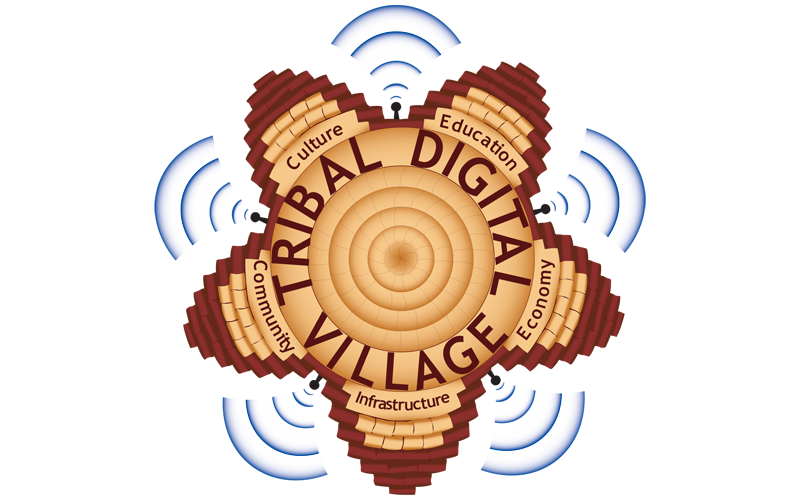About TDV
The Southern California Tribal Chairmen’s Association(SCTCA) is addressing the lack of Internet access for its tribal communities, taking their wireless broadband network to the next level of support for its communities, the “tribal home”. It has been a long term goal of the Tribal Digital Village(TDV), an SCTCA program that spawned the TDV Network (TDVNet) back in 2001 to bring Internet services to our key community buildings and programs. We have done the ground work to support key community operations on reservations, and created over 350 miles of point-to-point and point-to-multi-point links supporting 86 tribal buildings, i.e.- tribal administration buildings, EPA departments, fire stations, law enforcement, utilities departments, and Libraries, Schools and Head Start programs. We have the Infrastructure in place to support such an endeavor, and the desire from the people to have access to broadband. We are actively deploying the next phase of TDVNet’s deployment.
SCTCA’s primary function is to provide Tribal TANF (Temporary Aid to Need Families), and we support rural and urban San Diego, and Santa Barbara Counties. It is our job to perform this function for the people. Job training, education, GED, vocational certifications, career counseling, education counseling, and case work are all part of healing our community and creating a self-sufficient opportunity for everyone. In order to heal our community properly and provide all the resources to them, we need to bring Internet to the home.
There are 17 tribal reservation communities in San Diego County. They are Geographically located from N. Central spanning to the East, Then South and Back to South Central San Diego County. (creating a backwards “C” shape) There are approximately 2700 tribal homes on reservation, all of which are located in unserved rural communities. and over 2500 more in our adjacent non-tribal communities. Unserved in broadband Internet access. Unserved in affordable choices to obtain access to this very powerful resource at broadband speeds.The terrain is Mountainous, rocky and rural in setting even though it is within close proximity to the populations of San Diego County. There are no terrestrial broadband services available to fifteen of those reservations. Two of the reservations are located adjacent to a service that is cost-prohibitive and does not deliver the speeds in which the standard that we strive for as a goal for terrestrial fixed broadband wireless should deliver. Access to speeds in combination adding up to 5 Mbps is the goal for the 2700 homes on reservation, 8900 people on reservation by the last approximation at the Southern California Tribal Chairmen’s Association. There are 116 businesses located on or around the reservations that are passed by our network and lie within our foot print. There are 60 community anchor institutions, public safety entities, and critical community organizations passed and/or involved with project. All community anchor institutions are connected for FREE!! They have been for 10 years and will continue to receive service free of charge. New tribal facilities also get this same opportunity to have broadband Internet access at no cost.
It is the goal of SCTCA and TDVNet to support a Net-Neutral Internet solution. Net-neutrality is something that we’ve felt strongly about for the future of the Internet in the United States, and its importance for having a fully functional Internet. Our Network is very unique in that it is located exclusively on tribal land and it is tribal operated. Our Network currently serves the communities of 13 of the 17 sovereign nations in San Diego County, and is a “commercial” network for the purposes of sustainability, not financial gain. Fixed broadband wireless point-to-point, and point-to-multi-point connections, using 2.4Ghz, 5.3 Ghz, 5.8 Ghz, and FCC licensed spectrum. The Data center has a fiber-termination point, currently serving 250 Mbps. We continue to believe that unlicensed spectrum is perfect for deployment to the tribal home, and welcome the introduction of white spaces spectrum in the future. We have a good solution that is stable and reliable for supporting hundreds of homes per intermediate distribution tower. It is based on an access point distribution, subscriber unit acquisition. We operate a broadband infrastructure, that is sustainable, robust, and reliable. We are a Tribal owned and operated broadband services provider.
The TDV Network has been active and supporting the tribal communities for 10 years, and will continue to support the tribal municipalities and key community establishments. This is supported by SCTCA and its Member tribes. The staff and members of TDV have been building broadband wireless networks since 2001, and are considered field experts in community broadband development, deployment, design and management of broadband wireless networking. We currently have 10% of homes connected in 4 of the 17 inhabited reservations. 650 homes have adopted broadband, and we continue to expand our deployment daily. We will continue as long as there are homes that want service connections. We are providing broadband education, awareness, training, access, and support to Schools, libraries, medical and healthcare providers, and other community support organizations for support of our services and introduction to the endless possibilities with broadband Internet access. We are reaching out to communities that are poor, unserved and in need of access to this resource for job-creation, job training, higher education, and self-empowerment through our BTOP grant.
With the expansion to the tribal community homes, TDVNet and SCTCA will be fulfilling one of the major goals of its mission and that is to help its people get ahead in life. The Network goal is to eliminate yet another barrier placed upon the tribes. SCTCA is overcoming this barrier by meeting one of the original dream objectives of a highly successful program created in 2001, the Tribal Digital Village and its network will bring the people to the future with access to this technology.
The Tribal Digital Village Initiative is being led by the Director of Technology of SCTCA, Matthew Rantanen [mrantanen (at) sctdv.net]

